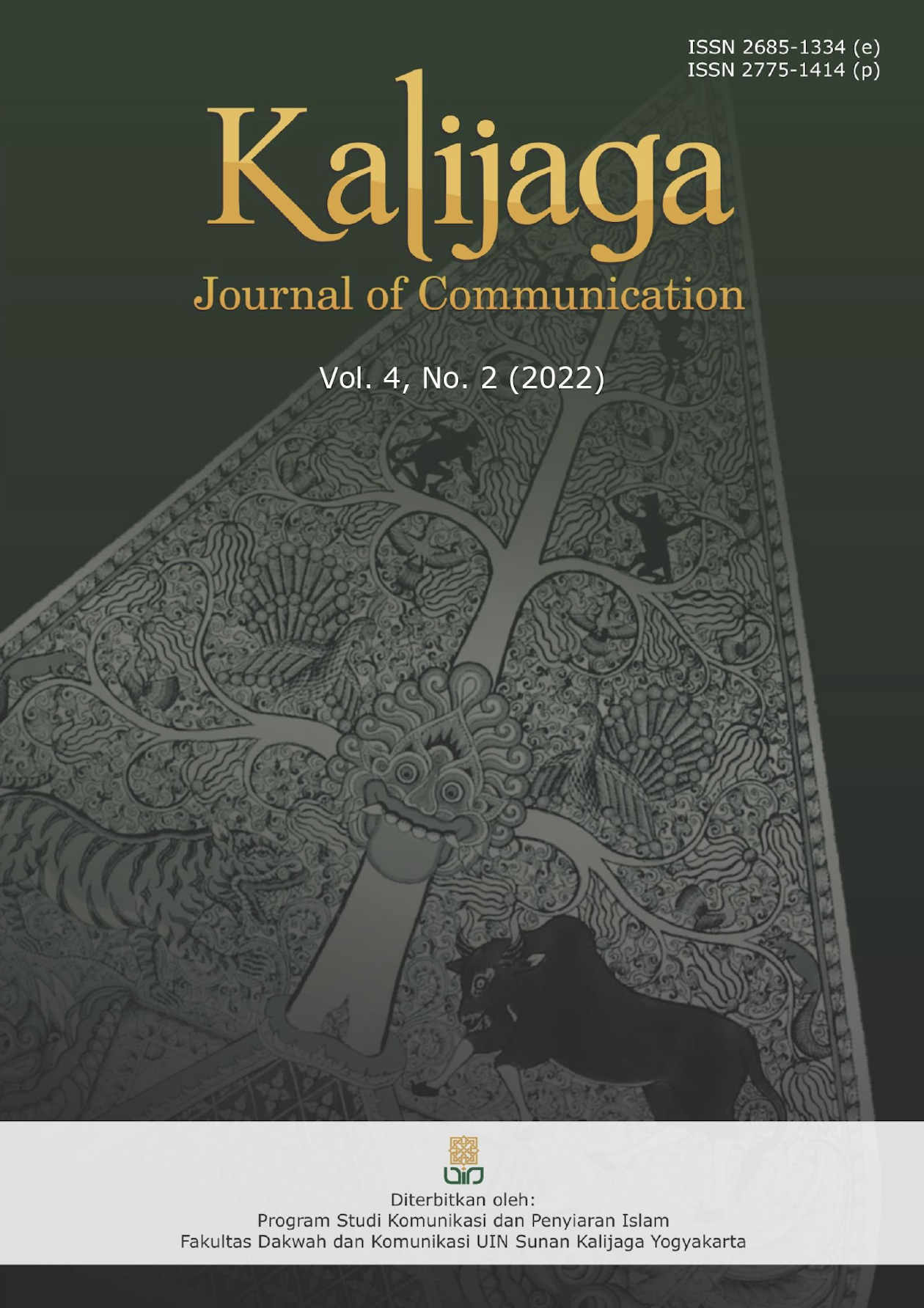Praktik Panoptikon pada Liputan Narasi TV tentang Tragedi Kanjuruhan
DOI:
https://doi.org/10.14421/kjc.42.01.2022Keywords:
Panopticon, Netizens, TV Narration, Data Journalism, Kanjuruhan TragedyAbstract
This article shows the practice of panopticon in the Kanjuruhan Stadium tragedy through coverage of Narasi TV's “Brutal Moments Approaching Mass Death”. The deaths of 135 people at the Kanjuruhan Stadium in Malang during the match between Arema FC and Persebaya Surabaya drew various opinions and news points of view. Through data journalism that relies on open sources on the internet, Narasi TV gets 4,500 to 5,000 photos/videos from netizens as eyewitnesses. These data are used by Narasi TV to monitor and view the Kanjuruhan Tragedy in a comprehensive manner. The large amount of data shows that panopticon practices from spectators at the Kanjuruhan Stadium have occurred. This Narasi TV coverage evidences that the authorities such as security officers can now also be monitored through panopticon netizens with complete validation and verification from the mass media. If previously the panopticon was in the form of top-down, with the presence of panopticon netizens, monitoring practices are now more balanced. This article uses the method of cybermedia analysis and interviews with producers of coverage to see how Narasi TV produces and at the same time looks at the practice of panopticon in this coverage.
 Abstract viewed: 1016 times
|
Abstract viewed: 1016 times
|
 PDF downloaded = 774 times
PDF downloaded = 774 times
References
Abidin, A. Z., & Rachma, I. (2018). Etnografi Virtual Sebagai Teknik Pengumpulan Data Dan Metode Penelitian. The Journal of Society & Media, 2(2), 130–145.
Asri, R. (2017). Hubungan media massa dan khalayak: reinterpretasi di era milenial. Media Dan Masyarakat Kini: Perkembangan Teknologi Komunikasi Dan Peran Media Baru Dalam Perubahan Gaya Hidup, 125–199.
Badri, M. (2017). Inovasi Jurnalisme Data Media Online di Indonesia. Indonesia Media Research Awards & Summit (IMRAS), 3.
Bataona, M. R. (2021). Anatomi Histeria Publik dan Panopticon : Dekonstruksi Arsitektur Komunikasi di Masa Pandemi. 5(April), 1–22. https://doi.org/10.15575/cjik.v5i1.12643
Boer, R. (2019). Peran Generasi Muda dalam Pemanfaatan Media Sosial untuk Relationship Marketing dan Mata Najwa Sebagai Bagian dari Strategi. ULTIMACOMM, 11(2).
Bozovic, M. (1995). Jeremy Bentham: The Panapticon Writings. Verso.
Brunon-Ernst, A. (2012). Beyond Foucault: New Perspective on Bentham’s Panopticon (A. Brunon-Ernst, Ed.). Ashgate.
D’Amico, R. (1978). Discipline and Punish: The Birth of the Prison. Telos, 1978(36), 169–183. https://doi.org/10.3817/0678036169
Flew, T. (2008). New Media: An Introduction (3rd ed.). Oxford University Press.
Foucault, M. (1977). Discipline and Punish: The Birth of the Prison. Pantheon.
Hauben, M. (1993). Common Sense The Net and Netizens: The Impact the Net Has on People’s Lives. ACN, 5.
Ismail, H. C. (2022). Korban Tragedi Kanjuruhan Jadi 135 Orang, Akmal TGIPF: Meninggal Tadi Malam. Tempo.Co. https://nasional.tempo.co/read/1648650/korban-tragedi-kanjuruhan-jadi-135-orang-akmal-tgipf-meninggal-tadi-malam
Jati, H. (2022). Ricuh Kanjuruhan Malang jadi Tragedi Sepak bola dengan Jumlah Korban Terbanyak Setelah Peru 1964. Kompas TV.
Kencana, W. H., & Djamal, M. F. (2021). Startup Television: New Form In Digital Journalism. Jurnal IKRA-ITH Humaniora, 5(2), 106–117.
Kovach, B., & Rosenstiel, T. (2006). Sembilan Elemen Jurnalisme. Pantau.
Kozinets, R. V. (2009). Netnography: Doing Ethnographic Research Online (1st ed.). Sage Publications Ltd.
Nasrullah, R. (2014). Teori dan Riset Media Siber (Cybermedia) (1st ed.). Kencana.
Newsroom, N. (2022a). BUKA MATA. Narasi TV. https://www.youtube.com/playlist?list=PL-zpqfQW17PwqpnLZg2ImhCcq7ZE0dbBo
Newsroom, N. (2022b). Momen-Momen Brutal Menjelang Kematian Massal. Narasi TV. https://www.youtube.com/watch?v=O4LlTg9bv4k
Newsroom, N. (2022c, August 25). Membongkar Manipulasi CCTV Sambo. Narasi TV. https://www.youtube.com/watch?v=MH_hzuxxeW8&t=71s
Permana, Rangga Saptya Mohamad, A. N. I. (2021). ANALISIS AGENDA SETTING TIM KREATIF NARASI TV TERHADAP PANDEMI COVID-19 MELALUI PROGRAM CERITA PANDEMI. Jurnal Ilmu Politik Dan Komunikasi, XI(1).
Ramadhan, M. (2017). Panopticonism dalam Media Massa (Analisis Wacana Berita Kasus Pemerkosaan Yn yang Ditayangkan pada Program AIMAN Kompas TV Mei 2016). Indonesian Journal of Criminology, 13(2), 229093.
Santana, S. (2004). Jurnalisme Investigasi. Yayasan Pustaka Obor Indonesia.
Sarifah, S., & Purwanto. (2020). Jurnalisme Investigasi Televisi di Kompas TV Jakarta: Studi Analisis Isi Kuantitatif dalam Naskah Berita “Berkas Kompas.” Jurnal Fotografi, Televisi, Animasi.
Syahputra, I. (2017). Post Media Literacy: Menyaksikan Kuasa Media Bersama Michel Foucault. Jurnal ASPIKOM, 1(1), 1. https://doi.org/10.24329/aspikom.v1i1.4
Tauches, J. (2017, May 25). What is a Panopticon? | Panopticon Prison Theory & Examples. Study.Com. What is a Panopticon? | Panopticon Prison Theory & Examples
Wahyudi, R. (2020). Dialektika antara Komunitas Mata Kita dan Narasi tv dalam Perpektif Strukturasi Giddens. Jurnal Komunikasi, 14(April). https://doi.org/10.20885/komunikasi.vol14.iss2.art1
Downloads
Published
Issue
Section
License
Copyright (c) 2022 Syafawi Ahmad Qadzafi

This work is licensed under a Creative Commons Attribution-ShareAlike 4.0 International License.
Authors who publish with this journal agree to the following terms:
- Authors retain copyright and grant the journal right of first publication with the work simultaneously licensed under a Creative Commons Attribution-NonCommercial-ShareAlike 4.0 International License. that allows others to share and adapt the work with an acknowledgement of the work's authorship and initial publication in this journal.
- Authors are able to enter into separate, additional contractual arrangements for the non-exclusive distribution of the journal's published version of the work (e.g., post it to an institutional repository or publish it in a book), with an acknowledgement of its initial publication in this journal.
- Authors are permitted and encouraged to post their work online (e.g., in institutional repositories or on their website) prior to and during the submission process, as it can lead to productive exchanges, as well as earlier and greater citation of published work (See The Effect of Open Access).






























